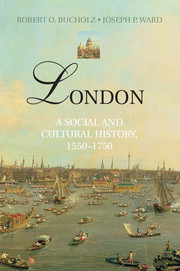Book contents
- Frontmatter
- Contents
- List of Illustrations and Maps
- List of Abbreviations and Conventions
- Acknowledgments
- Maps
- Introduction: London's Importance
- 1 London in 1550
- 2 The Socioeconomic Base
- 3 Royal and Civic London
- 4 Fine and Performed Arts
- 5 The Public Sphere and Popular Culture
- 6 The People on the Margins
- 7 Riot and Rebellion
- 8 Plague and Fire
- Conclusion: London in 1750
- Notes
- Further Reading
- Index
- Plate Section
3 - Royal and Civic London
Published online by Cambridge University Press: 05 November 2012
- Frontmatter
- Contents
- List of Illustrations and Maps
- List of Abbreviations and Conventions
- Acknowledgments
- Maps
- Introduction: London's Importance
- 1 London in 1550
- 2 The Socioeconomic Base
- 3 Royal and Civic London
- 4 Fine and Performed Arts
- 5 The Public Sphere and Popular Culture
- 6 The People on the Margins
- 7 Riot and Rebellion
- 8 Plague and Fire
- Conclusion: London in 1750
- Notes
- Further Reading
- Index
- Plate Section
Summary
The previous chapter addressed the business end of London, in particular the City and docks. In this chapter we move west to the court and government end of town before returning at its conclusion to the Guildhall and London's own administration. It might be objected that the court at Whitehall and Westminster might have been in London, but was not of London, since its most glittering inhabitants would probably have felt more at home at the courts of Versailles or Madrid than in the Royal Exchange or a City tavern. Although true, it is also true that the court was one of the major avenues to social advancement in London. Moreover, court and government were an integral part of the city's domestic economy: in the words of Daniel Defoe, “Between the Court and city, there is a constant communication of business.” We have already noted the involvement of London merchants and moneyed men in government finance and contracts. Below this level, scores of London tradesmen competed for the royal warrant naming them suppliers “in ordinary” to the household, and when the court left town or went into mourning (thus putting clothiers and haberdashers out of work), they did howl. Court rakes roamed the town looking for trouble, and many Londoners were amphibious between City and court: Samuel Pepys lived and worked in Seething Lane near the Tower, but he spent about a third of his year attending his superiors at, or just marveling at the sights and sounds of, Whitehall. Indeed, no visit to London was complete without a trip to court. Why?
- Type
- Chapter
- Information
- LondonA Social and Cultural History, 1550–1750, pp. 101 - 131Publisher: Cambridge University PressPrint publication year: 2012



